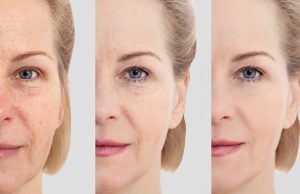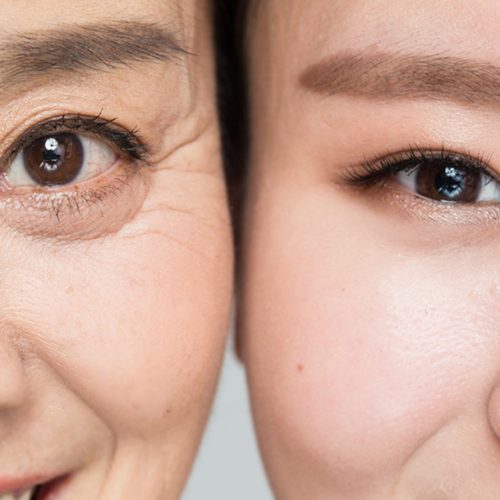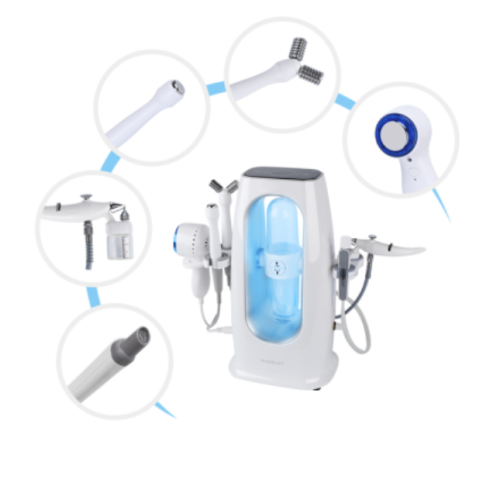
“Enhance Your Esthetician Services with a Hydrafacial Machine: Elevate Facial Rejuvenation for Your Clients”.
A Hydrafacial machine for estheticians is a specialized device designed to perform the Hydrafacial treatment, which is a popular non-invasive facial rejuvenation procedure. It combines various skincare techniques into a single machine, allowing estheticians to provide comprehensive and effective facial treatments to their clients.
The Hydrafacial machine typically incorporates several key components and steps:
Cleansing and Exfoliation: The machine uses a vortex technology to cleanse and exfoliate the skin, removing dead skin cells and impurities. This step helps to improve skin texture and prepare it for further treatments.
Acid Peel: Some Hydrafacial machines have a built-in feature for applying a gentle chemical peel. This step involves the application of a mild acid solution to further exfoliate the skin, promote cell turnover, and address specific skin concerns.
Extraction: A vacuum-like suction mechanism is used to extract impurities, blackheads, and debris from the skin’s surface. This step helps to deeply clean the pores and remove congestion.
Hydration and Serum Infusion: The machine utilizes a specialized hydrating solution or serum to nourish and moisturize the skin. This step involves the application of antioxidants, peptides, and hyaluronic acid to enhance skin health, hydration, and elasticity.
Optional Add-Ons: Some Hydrafacial machines offer additional features such as LED therapy or lymphatic drainage. LED therapy uses different wavelengths of light to target specific skin concerns, while lymphatic drainage can help reduce puffiness and promote detoxification.
Hydrafacial machines are designed to be efficient, safe, and customizable to suit individual client needs. They allow estheticians to deliver a tailored and effective treatment that addresses various skin concerns, including acne, hyperpigmentation, fine lines, and dullness.

Pros and Cons of Hydrafacial Machine for Estheticians
Pros:
Versatility and Customization: Hydrafacial machines provide estheticians with a versatile platform for delivering customized treatments. The ability to adjust treatment intensity, duration, and select specific serums allows for personalized experiences tailored to individual client needs.
Non-Invasive and Gentle: Hydrafacial treatments are non-invasive, devoid of incisions or harsh chemicals. The machine’s gentle exfoliation and extraction techniques make it suitable for clients with sensitive skin, minimizing the risk of adverse reactions.
Immediate and Noticeable Results: Hydrafacial treatments often yield immediate improvements in skin appearance. The machine’s comprehensive approach, encompassing cleansing, exfoliation, and hydration, leaves clients with visibly brighter, smoother, and rejuvenated skin.
Multi-Faceted Solution: The Hydrafacial machine effectively addresses a range of common skin concerns, including acne, hyperpigmentation, fine lines, and dullness. By consolidating multiple skincare techniques into one treatment, it optimizes time efficiency for both estheticians and clients.
Minimal Downtime: Unlike more invasive procedures, Hydrafacial treatments typically entail minimal downtime. Clients can promptly resume their daily activities, making it a convenient option for individuals with busy schedules.
Cons:
Financial Considerations: Acquiring a Hydrafacial machine represents a significant investment for estheticians, particularly those starting their practice or operating on a limited budget. Consideration should be given to initial costs, ongoing maintenance, and supply expenses.
Training and Expertise: Proficient operation of the Hydrafacial machine necessitates proper training and expertise. Estheticians must acquire knowledge of correct techniques, machine settings, and treatment protocols to ensure optimal results and client safety. Additional training and certification may be required.
Scope Limitations: While Hydrafacial machines offer versatility, they may not be universally suitable for all skin concerns or conditions. Estheticians should carefully assess client needs and be aware that more complex or severe issues may require alternative or supplemental treatments.
Machine Dependency: Incorporating a Hydrafacial machine into a practice entails reliance on its functionality for specific treatments. Estheticians should consider the potential implications if the machine requires repairs or maintenance, as it could temporarily impact service offerings.
Managing Client Expectations: Hydrafacial treatments yield noticeable improvements, but clients may have high expectations for long-term results. Estheticians must skillfully manage client expectations and provide comprehensive skincare education to ensure they understand the treatment’s limitations and potential need for multiple sessions.

Hydrafacial machine treatments
Hydrafacial machines offer a variety of treatments that can be tailored to address specific skin concerns. These treatments typically involve a combination of cleansing, exfoliation, extraction, hydration, and infusion of serums. Here are some common Hydrafacial machine treatments for estheticians:
Deep Cleansing and Hydration: This treatment focuses on thoroughly cleansing the skin, removing dirt, oil, and impurities. It also provides deep hydration to replenish moisture and promote a healthier complexion.
Acne Treatment: Designed for clients with acne-prone skin, this treatment includes targeted cleansing, gentle exfoliation, and extraction to clear clogged pores. It may also involve the application of serums with ingredients like salicylic acid to reduce inflammation and control oil production.
Brightening and Pigmentation Correction: This treatment aims to even out skin tone, reduce hyperpigmentation, and enhance overall radiance. It involves exfoliation, infusion of brightening serums containing ingredients like vitamin C, and potentially incorporating LED therapy to further address pigmentation concerns.
Anti-Aging and Wrinkle Reduction: This treatment focuses on reducing the appearance of fine lines and wrinkles, promoting collagen production, and improving skin elasticity. It often includes exfoliation, infusion of serums with peptides and antioxidants, and potentially incorporating LED therapy to stimulate cellular rejuvenation.
Sensitive Skin Soothing: This treatment is specifically designed for clients with sensitive or reactive skin. It involves gentle cleansing, hydrating serums with soothing ingredients like aloe vera or chamomile, and minimizing the use of potentially irritating components.
Lymphatic Drainage: Some Hydrafacial machines offer a lymphatic drainage treatment. It aims to improve circulation, reduce puffiness, and detoxify the skin by stimulating the lymphatic system. This treatment can be beneficial for clients with water retention, inflammation, or facial swelling.
Summary
Hydrafacial machines are advanced skincare devices used by estheticians to provide non-invasive and customizable facial treatments. These machines combine multiple skincare techniques into a single treatment session, offering a comprehensive approach to facial rejuvenation. Key components of Hydrafacial machines include cleansing and exfoliation, acid peels, extraction of impurities, hydration and serum infusion, and optional add-ons like LED therapy or lymphatic drainage.
The benefits of Hydrafacial machines for estheticians include their versatility and customization options, allowing for tailored treatments based on individual client needs. The treatments are non-invasive and gentle, suitable for sensitive skin types. Clients often experience immediate and noticeable results, such as improved skin texture, hydration, and a brighter complexion. Hydrafacial machines effectively address various skin concerns like acne, hyperpigmentation, and signs of aging.
However, there are considerations to keep in mind. Hydrafacial machines can represent a significant investment for estheticians, and proper training is necessary to operate them effectively and ensure client safety. While versatile, these machines may have limitations in treating complex or severe skin conditions. Estheticians should manage client expectations and provide skincare education to communicate the treatment’s limitations. Additionally, reliance on the machine for specific treatments and potential downtime during repairs or maintenance should be considered.
In summary, Hydrafacial machines offer estheticians a versatile and effective tool to provide personalized and non-invasive facial treatments. With proper training and understanding, these machines can enhance skincare services, providing clients with immediate results and a rejuvenated complexion.
